标签:
【首先声明:LCT≠动态树,前者是一种数据结构,而后者是一类问题,即:LCT—解决—>动态树】
Link-cut-tree(下文统称LCT)是一种强大的数据结构,不仅可以像树链剖分一样对树上的两点进行询问(权值和、权值的最值……),还可以维护森林的连通性。
学习LCT首推杨哲神犇的《QTREE解法的一些研究》,很详细地解释了LCT的概念及实现
本文则以ZOJ2114一题为例,分析LCT实现过程中的一些事项,并且力求读者对LCT有一个“不次于‘感性’的认识”
叙述过程中会直接引用论文中的术语
题目大意:
N个点(N<=2e4),M次操作(M<=4e4),维护N个点构成的森林
最初N个点两两不连通
U x y z:新建一条权值为z的边,把x所在树的根节点连到y所在的树上
Q x y:询问x到y的距离。如果x和y未连通,输出Not connected.
思路:
对于Q操作,如果x和y所属的根节点不同,那么x和y必然是不连通的
对于U操作,首先需要找到x和y的根节点(分别记作u和v),然后把u连到v上
查询根节点可以用并查集
我们需要对森林进行修改(合并树)及询问操作,树链剖分是无法胜任的(树剖只能用于静态树),所以我们考虑LCT
我们用Splay维护Auxiliary Tree(如果不知道这是什么,请看论文):
1 enum { Left=0,Right=1 }; 2 3 struct SplayNode; 4 SplayNode* vir; 5 6 struct SplayNode 7 { 8 int dist; 9 int totDist; 10 bool isRoot; 11 SplayNode* parent; 12 SplayNode* child[2]; 13 };
(为阅读方便,分割代码时作了一些修改)
vir的作用是代替空指针,从而免去很多不必要的判断
SplayNode类的成员变量如下:
dist:在森林(原图)中,该节点与父节点之间边的权值。
totDist:Auxiliary Tree中,以该节点为根的子树的dist之和
isRoot:该节点是否为所在Auxiliary Tree的根节点
child[]:该节点在Auxiliary Tree中的左右孩子。
parent:既可以是Auxiliary Tree内部的父节点,也可以是Auxiliary Tree整体的path-parent
(1)如果isRoot==false,那么parent表示该节点在Auxiliary Tree中的父节点
(2)如果isRoot==true,那么parent表示其所在Auxiliary Tree的path-parent,即其在森林中的父节点
也就是说,对于某个节点u,可能有多个节点以u为parent,但其中只有至多两个与u构成Auxiliary Tree。在编程实现中,这是一个值得注意的问题

如图,ABCDE构成森林中的一个连通分量,实线表示Preferred Child
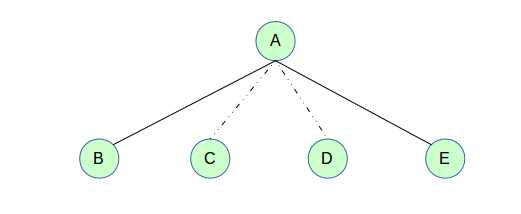
相应的Auxiliary Tree(Series)。实线表示Preferred Child关系,虚线表示Path Parent关系
在Auxiliary Tree中,我们“隐式”地把节点的深度作为BST的关键字。也就是说,中序遍历一棵Auxiliary Tree,得到的就是一条从上到下的Preferred Path链
(如果你不能理解从图1到图2的转换,复习一下LCT的相关定义)
之后是Splay的一些操作(成员函数):
1 void init() 2 { 3 dist=totDist=0; 4 isRoot=true; 5 parent=child[0]=child[1]=vir; 6 } 7 8 void update() 9 { 10 this->totDist = 11 child[Left]->totDist+child[Right]->totDist+this->dist; 12 } 13 14 void rotate(int dir) 15 //If dir==Right then rotate clockwise, else rotate counter-clockwise 16 { 17 if(parent==parent->parent->child[Left]) 18 parent->parent->child[Left]=this; 19 else if(parent==parent->parent->child[Right]) 20 parent->parent->child[Right]=this; 21 22 parent->child[dir^1]=this->child[dir]; 23 child[dir]->parent=this->parent; 24 25 child[dir]=parent; 26 parent=parent->parent; 27 child[dir]->parent=this; 28 } 29 30 void zigzig(int dir) 31 { 32 parent->rotate(dir); 33 this->rotate(dir); 34 35 child[dir]->child[dir]->update(); 36 child[dir]->update(); 37 this->update(); 38 } 39 40 void zigzag(int dir) //dir depends on first rotation 41 { 42 rotate(dir); 43 rotate(dir^1); 44 45 child[Left]->update(); 46 child[Right]->update(); 47 this->update(); 48 } 49 50 void zig(int dir) 51 { 52 rotate(dir); 53 child[dir]->update(); 54 this->update(); 55 } 56 57 void splay() 58 { 59 while(!isRoot) 60 { 61 int status=0; 62 if(this==parent->child[Left]) status|=1; 63 else status|=2; 64 65 if(!parent->isRoot) 66 { 67 if(parent->parent->isRoot) this->isRoot=true; 68 if(parent==parent->parent->child[Left]) status|=4; 69 else status|=8; 70 } 71 else 72 this->isRoot=true; 73 74 switch(status) 75 { 76 case 1: zig(Right); 77 child[Right]->isRoot=false; 78 break; 79 case 2: zig(Left); 80 child[Left]->isRoot=false; 81 break; 82 case 5: zigzig(Right); 83 if(isRoot) child[Right]->child[Right]->isRoot=false; 84 break; 85 case 6: zigzag(Left); 86 if(isRoot) child[Right]->isRoot=false; 87 break; 88 case 9: zigzag(Right); 89 if(isRoot) child[Left]->isRoot=false; 90 break; 91 case 10:zigzig(Left); 92 if(isRoot) child[Left]->child[Left]->isRoot=false; 93 break; 94 default:break; 95 } 96 } 97 }
各函数的说明:
init:初始化。令该节点成为独立的一个连通分量。
update:(在旋转以后)更新节点的totDist值。
rotate:将节点上旋。如果dir==Right,那么沿顺时针方向上旋;如果dir==Left,那么沿逆时针方向上旋。
zig,zigzig,zigzag:Splay的单双旋
splay:提根,将当前节点提到所在Auxiliary Tree的根部
17 if(parent==parent->parent->child[Left]) 18 parent->parent->child[Left]=this; 19 else if(parent==parent->parent->child[Right]) 20 parent->parent->child[Right]=this;
这里的判断需要特别注意。必须写成else if的形式(还记得我们是怎样定义parent的吗?)
另外splay的过程中涉及到isRoot的变化
除此之外其他的部分和普通的SplayTree大同小异,在这里就不多说了,详见代码。
至此,LCT的基础——SplayNode就已经打好了,接下来就是LCT的精华:Access(也有的版本称为Expose)操作:
1 int access(SplayNode* u) 2 { 3 SplayNode* v=vir; 4 int res=0; 5 while(u!=vir) 6 { 7 u->splay(); 8 u->child[Right]->isRoot=true; 9 res=u->child[Right]->totDist; 10 u->child[Right]=v; 11 v->isRoot=false; 12 u->update(); 13 v=u; u=u->parent; 14 } 15 return res + v->child[Right]->totDist; 16 } 17 18 inline int query(SplayNode* u,SplayNode* v) 19 { 20 access(u); 21 return access(v); 22 }
比起SplayNode的实现是不是短了许多?(斜眼笑
然而,正所谓浓缩就是精华,Access的原理可以说是不容小视的(毕竟是LCT所有操作的基石)
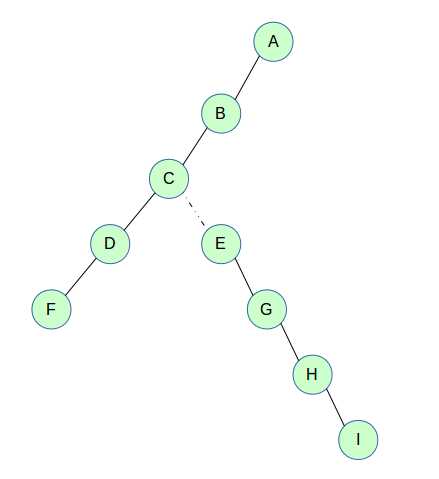
接下来我们以此图(以下称为原图)为例,演示access(H)的全过程。图为access(H)之前
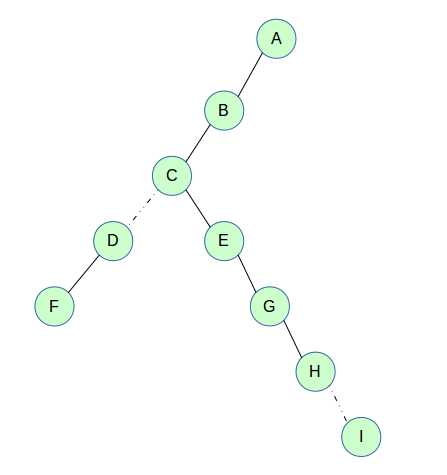
access(H)之后的效果图,可以看到途经的所有节点,其原来的Preferred Path都被切断了,取而代之的是“直达”H的Preferred Path
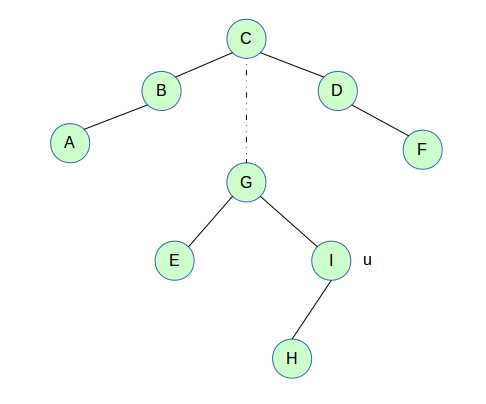
access(H)之前的Auxiliary Tree,也是我们操作的对象。
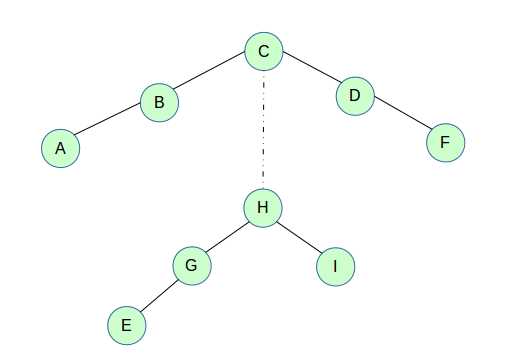
首先我们splay(H),把H提到所在Auxiliary Tree的根部
此时H的右子树对应原图中的Preferred Path
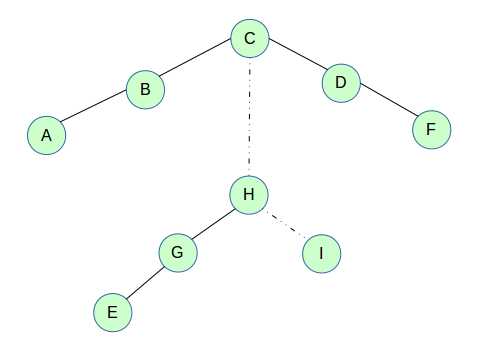
由于新的Preferred Path要“切断”沿途所有旧的Preferred Child,而H的右子树对应H原来的Preferred Child
所以H和I之间要断开,表示新的Preferred Path到H就中止了,以I为根的子树成为一棵新的Auxiliary Tree
之后别忘了update一下H的totDist
为了将A和H用Preferred Path相连,我们还要对H的Path Parent,也就是对C“开刀”
首先还是splay(C)。当然C已经是Auxiliary Tree的根节点了,所以对于本例,splay(C)什么都没做

然后依然将C与右子树D断开。
之后,我们要将C的Auxiliary Tree与H的Auxiliary Tree相连。由于H的Auxiliary Tree在原图中处于C的下方,所以H应该成为C的新的右孩子
如图所示,A和E已经用Preferred Path相连了。至此access(H)过程已经完成。不妨把此时的Auxiliary Tree和上面的效果图对比一下
当然在编程时我们需要一个判断条件:C的parent为vir,再往上走就没有任何意义了,所以access操作停止
……
那么,access的返回值是干嘛的?totDist到底有什么卵用?
举个栗子:询问D到H的距离。我们已经进行了access(H)

我们给每条边赋予一个权值(图中用黑色标注)

但在LCT的Auxiliary Tree中,这个权值实际上是存储到“下方”的节点中的(图中以红色标注)。括号中是totDist,括号外是dist
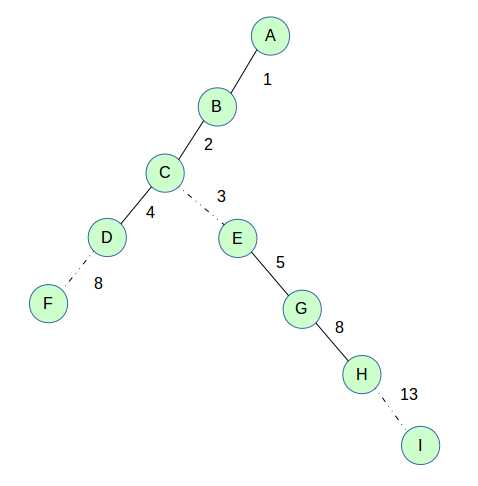
然后我们access(D)
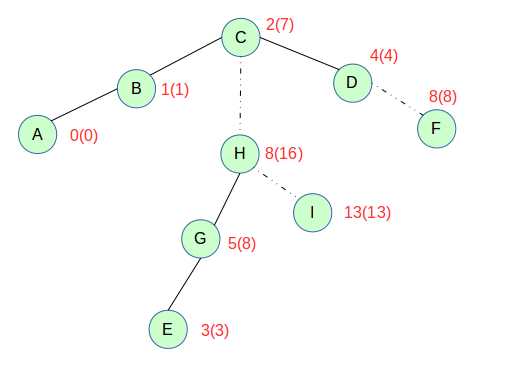
这是access(D)之后的Auxiliary Tree
在原图中,D到F的距离可以分解成D到C的距离和C到H的距离。之所以选择C是因为C是D和F的最近公共祖先(LCA)
而在Auxiliary Tree中,这恰好对应C的新、旧右孩子的totDist之和
H是C的”旧“右孩子,被D取代后,D就成了C的”新“右孩子
在编程过程中,我们需要设法保存”旧“右孩子的totDist值(要不然就失联了( ̄▽ ̄")),access函数中的res变量恰好胜任了这一要求
query函数中进行了两次access操作,第一次的返回值因为没有意义所以被丢弃了,而第二次的返回值就是询问的结果
问题已经解决了一半,接下来就是两个子树的合并(并不难):
1 const int maxN=20005; 2 int center[maxN]; 3 4 int getCenter(int x) 5 { 6 return center[x]==x ? x : 7 center[x]=getCenter(center[x]); 8 } 9 10 inline void link(int u,int v,int len) 11 { 12 access(node+u); 13 node[u].splay(); 14 center[u]=v; 15 node[u].parent=node+v; 16 node[u].dist=len; 17 node[u].update(); 18 }
center就是并查集,合并之前,首先要用getCenter函数找到两棵树的根节点u和v,然后把u连到v上
首先access(u),然后splay(u)
splay的目的是让u的parent成为vir,这样在连接u和v时,不会切断u所在的Auxiliary Tree
于是这道题用LCT完美解决(而且效率很高),附上完整代码:

1 #include <cstdio> 2 #include <cstring> 3 #include <algorithm> 4 5 enum { Left=0,Right=1 }; 6 7 struct SplayNode; 8 SplayNode* vir; 9 10 struct SplayNode 11 { 12 int dist; 13 int totDist; 14 bool isRoot; 15 SplayNode* parent; 16 SplayNode* child[2]; 17 18 void init() 19 { 20 dist=totDist=0; 21 isRoot=true; 22 parent=child[0]=child[1]=vir; 23 } 24 25 void update() 26 { 27 this->totDist = 28 child[Left]->totDist+child[Right]->totDist+this->dist; 29 } 30 31 void rotate(int dir) 32 //If dir==Right then rotate clockwise, else rotate counter-clockwise 33 { 34 if(parent==parent->parent->child[Left]) 35 parent->parent->child[Left]=this; 36 else if(parent==parent->parent->child[Right]) 37 parent->parent->child[Right]=this; 38 39 parent->child[dir^1]=this->child[dir]; 40 child[dir]->parent=this->parent; 41 42 child[dir]=parent; 43 parent=parent->parent; 44 child[dir]->parent=this; 45 } 46 47 void zigzig(int dir) 48 { 49 parent->rotate(dir); 50 this->rotate(dir); 51 52 child[dir]->child[dir]->update(); 53 child[dir]->update(); 54 this->update(); 55 } 56 57 void zigzag(int dir) //dir depends on first rotation 58 { 59 rotate(dir); 60 rotate(dir^1); 61 62 child[Left]->update(); 63 child[Right]->update(); 64 this->update(); 65 } 66 67 void zig(int dir) 68 { 69 rotate(dir); 70 child[dir]->update(); 71 this->update(); 72 } 73 74 void splay() 75 { 76 while(!isRoot) 77 { 78 int status=0; 79 if(this==parent->child[Left]) status|=1; 80 else status|=2; 81 82 if(!parent->isRoot) 83 { 84 if(parent->parent->isRoot) this->isRoot=true; 85 if(parent==parent->parent->child[Left]) status|=4; 86 else status|=8; 87 } 88 else 89 this->isRoot=true; 90 91 switch(status) 92 { 93 case 1: zig(Right); 94 child[Right]->isRoot=false; 95 break; 96 case 2: zig(Left); 97 child[Left]->isRoot=false; 98 break; 99 case 5: zigzig(Right); 100 if(isRoot) child[Right]->child[Right]->isRoot=false; 101 break; 102 case 6: zigzag(Left); 103 if(isRoot) child[Right]->isRoot=false; 104 break; 105 case 9: zigzag(Right); 106 if(isRoot) child[Left]->isRoot=false; 107 break; 108 case 10:zigzig(Left); 109 if(isRoot) child[Left]->child[Left]->isRoot=false; 110 break; 111 default:break; 112 } 113 } 114 } 115 }; 116 117 int access(SplayNode* u) 118 { 119 SplayNode* v=vir; 120 int res=0; 121 while(u!=vir) 122 { 123 u->splay(); 124 u->child[Right]->isRoot=true; 125 res=u->child[Right]->totDist; 126 u->child[Right]=v; 127 v->isRoot=false; 128 u->update(); 129 v=u; u=u->parent; 130 } 131 return res + v->child[Right]->totDist; 132 } 133 134 inline int query(SplayNode* u,SplayNode* v) 135 { 136 access(u); 137 return access(v); 138 } 139 140 void initVir() 141 { 142 vir=new SplayNode; 143 vir->init(); 144 } 145 146 const int maxN=20005; 147 148 SplayNode node[maxN]; 149 int center[maxN]; 150 int N,Q; 151 int lastRes=0; 152 153 inline void link(int u,int v,int len) 154 { 155 access(node+u); 156 node[u].splay(); 157 center[u]=v; 158 node[u].parent=node+v; 159 node[u].dist=len; 160 node[u].update(); 161 } 162 163 inline void initNode() 164 { 165 for(int i=1;i<=N;i++) node[i].init(); 166 for(int i=1;i<=N;i++) center[i]=i; 167 } 168 169 int getCenter(int x) 170 { 171 return center[x]==x ? x : 172 center[x]=getCenter(center[x]); 173 } 174 175 #define DEBUG 176 #undef DEBUG 177 178 #ifdef DEBUG 179 int qc=0; 180 #endif 181 182 void solve() 183 { 184 lastRes=0; 185 scanf("%d%d",&N,&Q); 186 initNode(); 187 char cmd; 188 int v1,v2,len; 189 while(Q--) 190 { 191 do cmd=getchar(); while(cmd==‘ ‘ || cmd==‘\n‘); 192 if(cmd==‘Q‘) 193 { 194 scanf("%d%d",&v1,&v2); 195 if(getCenter(v1)==getCenter(v2)) 196 printf("%d\n",lastRes=query(node+v1,node+v2)); 197 else printf("Not connected.\n"); 198 #ifdef DEBUG 199 printf("#%d query successful.\n",++qc); 200 #endif 201 } 202 else 203 { 204 scanf("%d%d%d",&v1,&v2,&len); 205 #ifndef DEBUG 206 v1=(v1-lastRes-1)%N; 207 if(v1<=0) v1+=N; 208 v2=(v2-lastRes-1)%N; 209 if(v2<=0) v2+=N; 210 #endif 211 link(getCenter(v1),getCenter(v2),len); 212 } 213 } 214 } 215 216 int main() 217 { 218 initVir(); 219 int X; scanf("%d",&X); 220 while(X--) solve(); 221 return 0; 222 }
从ZOJ2114(Transportation Network)到Link-cut-tree(LCT)
标签:
原文地址:http://www.cnblogs.com/Onlynagesha/p/5425209.html